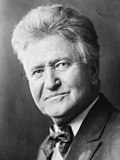| |||||||||||||||||||||||||||||||||||||
| |||||||||||||||||||||||||||||||||||||
 County Results
| |||||||||||||||||||||||||||||||||||||
| |||||||||||||||||||||||||||||||||||||
| Elections in Minnesota |
|---|
 |
The 1924 United States presidential election in Minnesota took place on November 4, 1924, in Minnesota as part of the 1924 United States presidential election. Voters chose 12 electors, or representatives to the Electoral College, who voted for president and vice president.
A rapid recovery from the depression of 1920 and 1921, despite major Republican losses during the 1922 House elections[1] placed the Republican Party – who gained a record popular-vote majority in the 1920 election – in a secure position despite the death of President Warren G. Harding in 1923. Rises in wages and ebbing of discontent further solidified the GOP's hold on power.[1]
More critically, the Democratic Party was mortally divided between its rural Southern faction led by William Gibbs McAdoo and its white ethnic urban northeastern faction led by New York Governor Al Smith.[2] The rural faction was supported by the revived Ku Klux Klan and was in favour of Prohibition, whereas the white ethnic faction was firmly against the anti-Catholic Klan and opposed to Prohibition. A fierce debate ensued that saw a compromise candidate, former Congressman John W. Davis of West Virginia, nominated after one hundred and three ballots in hot summer weather at Madison Square Garden.[3] Although West Virginia was a border state whose limited African-American population had not been disenfranchised as happened in all former Confederate States,[4] Davis did share the extreme social conservatism of Southern Democrats of his era. He supported poll taxes, opposed women's suffrage, and believed in strictly limited government with no expansion in nonmilitary fields.[5]
In the liberal, heavily Scandinavian Upper Midwest, Davis' social and economic views had practically no appeal.[6] Although in September Davis underwent an extensive tour of the region and of the Great Plains,[7] and campaigned to eliminate the income tax burden of the poorer classes,[8] he received a mere 6.80 percent of the vote in Minnesota. This constitutes the second-smallest proportion of any state's popular vote received by an official on-ballot[a] Democratic presidential nominee since the election of 1860, when the party was divided.[b] The only smaller proportion was by Grover Cleveland in Nevada in 1892, when he received only 6.56 percent of the vote.
The conservatism of Coolidge and Davis made it inevitable that aging Wisconsin maverick Robert M. La Follette would mount a third-party challenge – which La Follette had planned even before the Democratic Convention.[8] La Follette was formally nominated on July 4 by the "Conference for Progressive Political Action" and developed a platform dedicated to eliminating child labor and American interference in Latin American political affairs, along with a formal denunciation of the Ku Klux Klan.[9] La Follette also proposed major judicial reforms including amendments allowing congress to override judicial review and to re-enact laws declared unconstitutional.[10] La Follette also called for election of federal judges for ten-year terms.[11]
Davis and Coolidge both spent most of their campaign attacking La Follette as a political extremist,[11] but nonetheless opinion polls showed that La Follette was attracting large numbers of those German-American and Scandinavian-Americans who completely deserted Cox in 1920.[12] In September some polls had La Follette winning sufficient electoral votes to give no candidate an electoral majority and force the House to make a choice,[13] but as polling day approached newer polls suggested incumbent President Calvin Coolidge would hold the states of Minnesota, North Dakota, South Dakota, Nevada and Montana, which La Follette had been predicted to win in August.[13] As it turned out, Coolidge won the state over La Follette by a margin of 81,567 votes, or 9.92 percent. Nationally, the incumbent president almost equalled Harding's landslide popular vote victory, achieving a 25.22 percent lead over Davis and 382 electoral votes.
- ^ a b Ayers, Edward; Gould, Lewis; Oshinsky, David and Soderlund, Jean; American Passages: A History of the United States, Volume II: Since 1865, p. 677 ISBN 0547166354
- ^ Grantham, Dewey; The South in Modern America A Region at Odds, p. 106 ISBN 1610753895
- ^ Paulson, Arthur C.; Realignment and Party Revival: Understanding American Electoral Politics at the Turn of the Twenty-First Century, p. 51 ISBN 0275968650
- ^ Ranney, Joseph A.; In the Wake of Slavery: Civil War, Civil Rights, and the Reconstruction of Southern Law; p. 141 ISBN 0275989720
- ^ Newman, Roger K.; The Yale Biographical Dictionary of American Law, p. 153 ISBN 0300113005
- ^ Stark, Rodney and Christiano, Kevin J.; 'Support for the American Left, 1920-1924: The Opiate Thesis Reconsidered'; Journal for the Scientific Study of Religion, Vol. 31, No. 1 (March, 1992), pp. 62-75
- ^ Tucker, Garland; High Tide of American Conservatism: Davis, Coolidge, and the 1924 Election, p. 191 ISBN 193711029X
- ^ a b Richardson, Danny G.; Others: "Fighting Bob" La Follette and the Progressive Movement: Third-Party Politics in the 1920s, p. 180 ISBN 0595481264
- ^ Richardson; Others, pp. 182-183
- ^ Moreno, Paul D.; The American State from the Civil War to the New Deal: The Twilight of Constitutionalism and the Triumph of Progressivism, p. 205 ISBN 1107067715
- ^ a b Parrish, Michael E.; Anxious Decades: America in Prosperity and Depression, 1920-1941, pp. 70-71 ISBN 0393311341
- ^ Tucker; High Tide of American Conservatism, p. 181
- ^ a b Tucker; High Tide of American Conservatism, p. 231
Cite error: There are <ref group=lower-alpha> tags or {{efn}} templates on this page, but the references will not show without a {{reflist|group=lower-alpha}} template or {{notelist}} template (see the help page).



